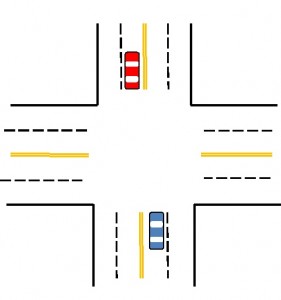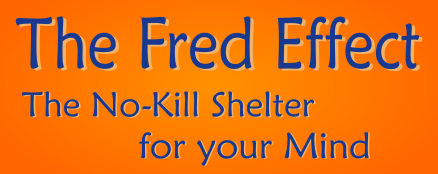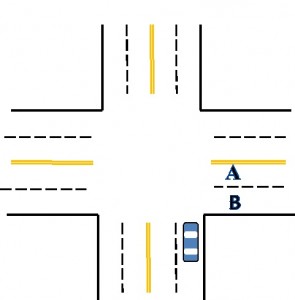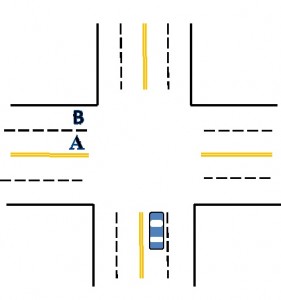Learner's Permit Study Guide #2
Read pages 11-28 of the Kansas Driving Handbook and answer the questions in the quiz below. Some of the questions have multiple answers, so be sure to select ALL correct answers.
Start
Congratulations - you have completed Learner's Permit Study Guide #2.
You scored %%SCORE%% out of %%TOTAL%%.
Your performance has been rated as %%RATING%%
Your answers are highlighted below.
Question 1 |
Driving is
A | my right as a citizen. |
B | the right of all people. |
C | a right guaranteed by The Constitution. |
D | a privilege granted to responsible citizens. |
Question 2 |
Bad, sloppy drivers
A | are stopped and removed from behind the wheel immediately. |
B | are not legally qualified to drive a motor vehicle. |
C | are always on the road somewhere. Hint: There are two correct answers here. |
D | can turn a vehicle into a destructive weapon. Hint: There are two correct answers here. |
Question 2 Explanation:
Great job!
Question 3 |
The governing principle for all Kansas speed laws means that you must always drive
A | exactly at the posted speed limit. |
B | at least five mph under the posted speed limit. |
C | at a speed that is reasonable and prudent for road and vehicle conditions. |
D | in the left lane on the interstate. |
Question 4 |
Speed for school buses is set by
A | the posted speed limit unless otherwise determined by school district policy. |
B | the principal of the school. |
C | whatever the speed limit sign says. |
D | whatever is 5 mph under the speed limit sign. |
Question 5 |
When changing lanes you must deploy a turn signal
A | 10 feet before beginning the maneuver. |
B | 300 feet before beginning the maneuver. |
C | 100 feet before beginning the maneuver. |
D | half a block before beginning the maneuver. |
Question 6 |
A motorcycle OR bicycle is entitled to
A | turn and change lanes without signaling. |
B | use of half the lane it occupies. |
C | go through red lights if there is no cross traffic |
D | the full use of the lane it occupies. |
Question 7 |
You must deploy a turn signal
A | 10 feet before making a turn. |
B | 100 feet before making a turn. |
C | 200 feet before making a turn. |
D | 1 block before making a turn. |
Question 8 |
A | lane A. |
B | lane B. |
C | lane A, then lane B. |
D | it doesn’t matter. |
Question 9 |
A | lane A. |
B | lane B. |
C | lane B, then lane A. |
D | it doesn’t matter. |
Question 10 |
If you are turning left in the blue car in the diagram below, and the red car is continuing straight, you should


A | turn as quickly as possible. |
B | assume the driver of the red car is going to slow down and let you turn. |
C | assume the driver of the red car might turn left. |
D | yield to the red car. |
Question 11 |
Large vehicles like trucks and busses
A | often use two lanes when turning |
B | can be passed on a right turn. |
C | should be made smaller. |
D | should not be on city streets. |
Question 12 |
When passing on a two-lane road, a driver must consider:
A | Is it safe? |
B | Is it legal? |
C | Is it worthwhile? |
D | all of the above. |
Question 13 |
The proper steps in passing on a two-lane highway are as follows.
A | deploy left turn signal, check mirrors, change lanes, accelerate and pass, return to right lane, deploy right turn signal, check mirrors, consider whether it was safe. |
B | consider whether passing is safe, check mirrors, deploy left turn signal, change lanes, accelerate and pass, deploy right turn signal, return to right lane, check right mirror. |
C | consider whether passing is safe, legal, and worthwhile, check left mirror, deploy left turn signal, change lanes, accelerate and pass, check right mirror, deploy right turn signal, return to right lane, cancel right turn signal. |
D | just floor it. |
Question 14 |
No passing is allowed
A | across a double solid yellow line. Hint: There is more than one correct answer here! |
B | across a single solid yellow line on your side of center. Hint: There is more than one correct answer here! |
C | with 100 feet of a bridge or tunnel. Hint: There is more than one correct answer here! |
D | within 100 feet of an intersection or railroad crossing. Hint: There is more than one correct answer here! |
Question 14 Explanation:
Excellent!
Question 15 |
“Road conditions” means
A | the laws and the heaviness of the traffic. |
B | the laws, the weather, and the traffic. |
C | the laws, the weather, the surface of the roadway, the traffic, the condition of your vehicle, and the condition of all other vehicles and drivers including yourself. |
D | the weather and the surface of the roadway. |
Question 16 |
Under normal conditions, a safe distance for following the vehicle in front of you is
A | 100 feet. |
B | one car length. |
C | two seconds. |
D | three car lengths. |
Question 17 |
The two-second following distance rule means
A | you have two seconds to stop your car. |
B | it should take your car two full seconds to reach a road marker that was passed by the car in front of you. Hint: Good job! There are two correct answers, here. |
C | when a car in front of you passes a sign or a crack in the pavement, two full seconds should elapse before your car passes the same sign or crack. Hint: Good job! There are two correct answers, here. |
D | you should count in English only. |
Question 18 |
When a school bus, church bus, or daycare bus is stopped to load or unload passengers, you must
A | slow down and pass carefully. |
B | stop and wait until all the passengers are off, then proceed slowly. |
C | stop and wait until the door is closed. |
D | stop and remain stopped until sign is retracted and red flashing lights are turned off. |
Question 19 |
When two vehicles approach a four-way or uncontrolled intersection from different roadways at approximately the same time,
A | the driver on the right yields to the driver on the left. |
B | the driver on the left yields to the driver on the right. |
C | the smaller vehicle yields to the larger vehicle. |
D | the larger vehicle yields to the smaller vehicle. |
Question 20 |
A “YIELD” sign means
A | stop only when necessary to avoid interfering with other traffic that has the right-of-way, including pedestrians. |
B | slow down and almost stop. |
C | stop; then proceed immediately. |
D | stop; then proceed after looking. |
Question 21 |
Parking is NOT allowed
A | within 5 feet of a fire hydrant. |
B | within 15 feet of a fire hydrant. |
C | within 50 feet of a fire hydrant. |
D | within one car length of a fire hydrant. |
Question 22 |
Parking is NOT allowed
A | within 50 feet of a railroad crossing. Hint: There is more than one correct answer here! |
B | on a bridge or in a tunnel. Hint: There is more than one correct answer here! |
C | in crosswalks or intersections. Hint: There is more than one correct answer here! |
D | to obstruct driveways or sidewalks. Hint: There is more than one correct answer here! |
Question 22 Explanation:
Awesome!
Question 23 |
A driver has more responsibility than a pedestrian because
A | drivers are smarter than pedestrians. |
B | motorized vehicles have more potential for destruction. |
C | motorized vehicles cause pollution. |
D | pedestrians don't have drivers' licenses. |
Question 24 |
A blind pedestrian has the legal right of way when
A | wearing a white cloth tied around the arm. Hint: Sorry, no. |
B | accompanied by another person. Hint: Not this one. |
C | accompanied by a service dog. Hint: There are two correct answers here. |
D | using a white cane. Hint: There are two correct answers here. |
Question 24 Explanation:
Good job!
Question 25 |
Sending or receiving text messages while driving
A | is permissible if no pedestrians are present. |
B | is permissible if the driver has not been drinking alcohol. |
C | is allowed if the driver owns the car. |
D | is illegal in Kansas. |
Question 26 |
A driver whose blood, urine, or breath analysis result shows a blood alcohol content of more than .08
A | will be fined not more than $100. |
B | will receive a warning for the first offense. |
C | will have a license suspension of at least 30 days. |
D | will have a license suspension of not more than 10 days. |
Question 27 |
A driver under the age of 21 will receive a license suspension of at least 30 days
A | if his/her blood alcohol content is .08 or higher. |
B | if his/her blood alcohol content is .06 or higher. |
C | if his/her blood alcohol content is .04 or higher. |
D | if his/her blood alcohol content is .02 or higher. |
Question 28 |
“D.U.I.” is an abbreviation for
A | Driver’s User Interface. |
B | Driving Under the Influence of Intoxicants. |
C | Don’t Use Intoxicants. |
D | Drunks Under Investigation |
Question 29 |
A driver who refuses to submit to any test for blood alcohol content
A | will receive an automatic license suspension for one year. |
B | will avoid prosecution for D.U.I. |
C | will receive a warning for the first offense. |
D | will receive an automatic license suspension for six months. |
Question 30 |
A seat belt must be worn
A | by the driver of the vehicle only. |
B | by ALL occupants of the vehicle at speeds over twenty m.p.h. |
C | only when traveling distances of more than one mile. |
D | by ALL occupants of the vehicle when the vehicle is in motion. |
Question 31 |
When meeting an oncoming vehicle at night, you must dim your headlights
A | within 200 feet of the oncoming vehicle. |
B | within 300 feet of the oncoming vehicle. |
C | within 400 feet of the oncoming vehicle. |
D | within 500 feet of the oncoming vehicle. |
Question 32 |
When driving in fog, you should use headlights on
A | high beam because they penetrate the fog. Hint: Nope. They do not! |
B | low beam because you can see the road better. Hint: There are two correct answers here. |
C | high beam so that other drivers can see you better. Hint: Nope. |
D | low beam because high beam reflects off the fog and back into your eyes. Hint: There are two correct answers here. |
Question 32 Explanation:
Excellent!
Question 33 |
Headlights are required
A | from sunrise to sunset. Hint: No. This is daytime. |
B | from sunset to sunrise. Hint: There are two correct answers here. |
C | unless there is a full moon. |
D | when good visibility is 1000 feet or less. Hint: There are two correct answers here. |
Question 33 Explanation:
Good job!
Question 34 |
Hydroplaning
A | means that traction is reduced by water on the roadway. Hint: There is more than one correct answer here! |
B | can be reduced by deeper treads and newer tires. Hint: There is more than one correct answer here! |
C | can be reduced by reducing speed. Hint: There is more than one correct answer here! |
D | increases with increased speed. Hint: There is more than one correct answer here! |
Question 34 Explanation:
Great job!
Once you are finished, click the button below. Any items you have not completed will be marked incorrect.
Get Results
There are 34 questions to complete.
← |
List |
→ |
Return
Shaded items are complete.
| 1 | 2 | 3 | 4 | 5 |
| 6 | 7 | 8 | 9 | 10 |
| 11 | 12 | 13 | 14 | 15 |
| 16 | 17 | 18 | 19 | 20 |
| 21 | 22 | 23 | 24 | 25 |
| 26 | 27 | 28 | 29 | 30 |
| 31 | 32 | 33 | 34 | End |
Return
You have completed
questions
question
Your score is
Correct
Wrong
Partial-Credit
You have not finished your quiz. If you leave this page, your progress will be lost.
Correct Answer
You Selected
Not Attempted
Final Score on Quiz
Attempted Questions Correct
Attempted Questions Wrong
Questions Not Attempted
Total Questions on Quiz
Question Details
Results
Date
Score
Hint
Time allowed
minutes
seconds
Time used
Answer Choice(s) Selected
Question Text
All done
Need more practice!
Keep trying!
Not bad!
Good work!
Perfect!



